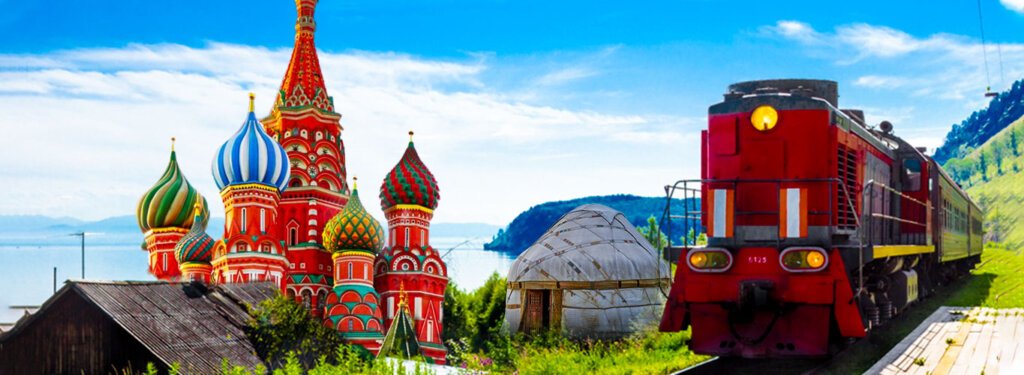
South India's No. 1 Travel Agency ✨
💱 Currency
Russian Ruble (RUB)
🗣️ Languages
Russian (official), regional languages like Buryat and Tatar
🌤️ Climate
-30°C to 30°C (extreme winter cold in Siberia; mild to warm summers)
📅 Best Season
May – September (Late spring to early autumn for pleasant travel and sightseeing)
🛡 Must-Know Travel Tips for Riding the Trans-Siberian Railway
- 🚉 Book tickets in advance, especially during summer or holiday seasons — choose between 1st, 2nd, or 3rd class based on your comfort needs.
- 💳 Credit cards are accepted in major stations and cities, but carry cash for smaller stops or onboard purchases.
- 📦 Pack essentials like snacks, a reusable water bottle, toilet paper, and entertainment — some stretches between towns are long and remote.
- 🌐 Internet is limited onboard; mobile data works in towns, so download maps or translation apps before boarding.
- 🤝 Russian people along the route can be reserved but helpful — learning a few Russian phrases can go a long way in building rapport.
- 🎒 A journey on the Trans-Siberian is not just a train ride — it's a cultural adventure through forests, steppes, and mountains across Eurasia.
What Is Trans-Siberian Famous For? – About the Trans-Siberian Explained
The Trans-Siberian Railway is globally recognized as one of the most iconic and enduring train journeys in the world. It spans over 9,200 kilometers from Moscow to Vladivostok, connecting the farthest ends of Russia through a continuous ribbon of steel. This legendary route crosses eight time zones, making it the longest railway line on Earth, and showcases the awe-inspiring geography of Russia—from the grandeur of European cities to the wilderness of Siberia and the coastlines of the Pacific.What makes the Trans-Siberian truly extraordinary is the diversity of culture and scenery travelers witness along the way. The journey passes through major cities like Yekaterinburg, Irkutsk, Ulan-Ude, and Khabarovsk, where each region has its own dialects, traditions, and architectural character. Travelers booking Trans Siberian tour packages often seek this cultural richness along with panoramic views and offbeat experiences. Beyond cityscapes, the railway offers immersive views of rural Russia, dense taiga forests, meandering rivers, and vast steppes that stretch to the horizon. The experience offers a unique sense of time travel, where ancient wooden houses still line small village stations and modern Russian society blends with its nomadic and religious heritage. Traveling on the Trans-Siberian is not just about reaching a destination—it’s about surrendering to a slower rhythm of life, where you read, reflect, and meet fellow travelers in cozy compartments. Whether you ride a simple local train or a luxurious cabin with all amenities, the Trans-Siberian Railway has become a rite of passage for adventurers who want to experience the raw, spiritual, and geographical heart of Eurasia.
Trans Siberian Tour Packages
Most Chosen Trans Siberian Plans by Our Happy Customers
How Are India and the Trans-Siberian Connected? – Cultural & Historical Ties
India and Russia have enjoyed a long-standing diplomatic, cultural, and academic relationship that dates back to the Soviet era. These historical ties naturally extend to the Trans-Siberian Railway, especially as more Indian travelers, students, and history enthusiasts seek to experience the cultural richness of Russia through its most iconic railway. Over the decades, many Indian professionals and students studied in Soviet institutions, contributing to a cultural bridge that has only grown stronger with time.
This connection is also spiritual in parts. The Republic of Buryatia, located along the Trans-Siberian route, is home to Russian Buddhists who follow Mahayana traditions similar to those found in India. Statues of Buddha, monasteries, and chanting monks in Ulan-Ude and surrounding areas provide Indian travelers with a familiar sense of religious and philosophical connection. It is a unique blend of Siberian and Indian spiritual roots in a snowy Russian landscape. In recent years, travel companies have begun curating special itineraries that cater specifically to Indian travelers, including vegetarian meals, bilingual guides, and cultural tours of Russian cities with Indian-friendly narratives. Whether it’s a shared reverence for train travel, a fascination with Russia’s socialist legacy, or an eagerness to explore Buddhist outposts, the connection between India and the Trans-Siberian journey is as much emotional as it is geographical.
Interesting Things to Know About the Trans-Siberian Before You Go
Embarking on a Trans-Siberian journey is an adventure that requires both curiosity and preparation. One of the most important things to understand is that the Trans-Siberian is not a single tourist train, but a route served by a series of local and express trains. Some travelers prefer the authentic Russian experience with standard Russian Railways trains, while others choose private luxury services that offer plush cabins and gourmet meals. The flexibility to stop in towns and cities along the way is one of the biggest draws, allowing travelers to personalize their journey based on interest, duration, and budget. Traveling on the Trans-Siberian also offers a unique social experience. Compartments often become shared spaces of camaraderie, storytelling, and cultural exchange. You may be sharing a four-berth cabin with locals, fellow backpackers, or long-distance traders, each with their own story. The rhythm of the train, the sound of wheels on the tracks, and long hours gazing out at birch forests create a meditative environment that slows down time and encourages introspection.While the landscape is undeniably breathtaking, the magic also lies in the ordinary moments—buying hot pastries from station vendors, sipping steaming tea from a samovar, or being handed a chocolate bar by a fellow passenger. These simple exchanges form the soul of the Trans-Siberian experience, where the journey becomes a microcosm of the wider world and a reminder of how vast, diverse, and beautiful life can be across continents.
What to Know Before Booking a Trans-Siberian Tour Package
Booking a Trans-Siberian tour is not just a logistical step—it’s the foundation for a once-in-a-lifetime journey. Before you start, decide whether you want a continuous journey or one broken up with stopovers. Most travelers choose the second option, allowing time to explore fascinating cities like Irkutsk, Kazan, and Ulan-Ude. Depending on your chosen route, you may also pass through Mongolia or China, so understanding the visa requirements for each country in advance is essential, especially for Indian passport holders.Choosing the right level of comfort is another key factor. While first-class cabins offer privacy and amenities, second and third-class experiences bring you closer to local culture and fellow travelers. Budget-friendly group packages might include shared cabins, local guesthouses, and walking tours, while luxury packages provide en-suite cabins, professional guides, and gourmet meals. The diversity in package types means there’s something for solo travelers, couples, and families alike. Booking through an experienced operator can make the process smooth. They can help arrange multi-entry visas, guide you through train schedules, and offer pre- and post-journey tours in Moscow or Beijing. Some even offer cultural enhancements like cooking classes, museum visits, and lake excursions. Booking early is also important—especially during the summer months—when seats sell out quickly, particularly for the more scenic sections between Irkutsk and Vladivostok.
Which Are the Best Budget Trans-Siberian Tour Packages?
The Trans-Siberian Railway has long had the reputation of being a dream for luxury train enthusiasts, but it is also highly accessible to budget-conscious travelers. The most affordable way to experience it is by using local trains and selecting second- or third-class cabins, which are clean, safe, and offer the most authentic interactions. Many independent travel agencies and backpacker communities offer guides on how to book tickets directly through the Russian Railways website or through trusted third-party services.Some of the most in-demand Trans Siberian tour packages include essentials like train tickets, hostel or mid-range hotel stays, and guided walking tours in stopover cities. These packages offer a balance of cultural immersion and convenience without the high costs of luxury services.
Budget-friendly tour packages from India often include Moscow to Irkutsk or Vladivostok with a mix of train tickets, budget hotel stays, and guided city walks. These tours usually span 10–14 days and are flexible, allowing travelers to add optional excursions like a boat ride on Lake Baikal or a walking tour through Kazan’s historic district. Some packages even combine Mongolia or Beijing for a multicultural twist without increasing the cost significantly. Traveling during the shoulder seasons—like May or September—can save costs while still offering favorable weather. Booking in advance is essential to lock in low fares, and bringing snacks and essentials from home helps avoid high onboard dining costs. Despite traveling on a budget, the richness of landscapes, the cultural conversations, and the stories gathered along the way make it a priceless experience that doesn’t require a luxury price tag.
Quick Facts About the Trans-Siberian – Geography, Wildlife & People
The Trans-Siberian Railway travels through a geographic canvas as diverse as it is vast. It begins in the grand European capital of Moscow, traverses the rolling hills of the Ural Mountains—considered the natural divide between Europe and Asia—and then stretches into the seemingly endless Siberian plain. Along the way, the train crosses rivers like the Ob, Yenisei, and Amur, and brushes the southern edge of Lake Baikal, the world’s oldest and deepest freshwater lake. The ecosystem along the route is equally diverse. In western regions, travelers see birch forests and cultivated farmlands. As the journey pushes eastward, the train moves into taiga forests, grasslands, and even tundra-like regions. Lake Baikal, a natural wonder, is home to rare species like the Baikal seal and is surrounded by snow-capped mountains and pine forests that change color with the seasons. It’s not uncommon to spot eagles, elk, and even wolves during the journey, especially if you’re traveling during spring or early autumn. The people you meet on the Trans-Siberian are just as varied as the geography. From Orthodox Christians in European Russia to Buddhist monks in Buryatia and indigenous Siberians in wooden villages, the human landscape reflects centuries of migration, conquest, and coexistence. Conversations in the dining car might shift from Russian to Mongolian to Chinese depending on where you are, and each region introduces its own cuisine, dress, and rhythm of life. In a country as expansive as Russia, the Trans-Siberian is the thread that ties it all together—geographically, culturally, and spiritually.
Trans Siberian Tour Packages
| High Season | May to September (Summer), December to February (Winter for snow lovers) |
|---|---|
| Iconic Attractions | Lake Baikal, Moscow Kremlin, St. Basil’s Cathedral, Ulaanbaatar, Siberian Taiga, Vladivostok Port |
| Popular Activities | Scenic Train Ride, Russian Banya Experience, Siberian Wildlife Spotting, Ice Fishing (Winter), Hiking around Lake Baikal |
| Visa | Visa required for most nationalities. Russia, Mongolia, and China portions may need separate visas (check latest rules by route and nationality) |
| National Animal | Russian Brown Bear |
| National Flower | Chamomile (Russia) |
| Famous Food | Borscht, Pelmeni, Blini, Shashlik (skewered meat), Siberian Fish Dishes, Russian Tea with Preserves |
Top Reasons Why Tourists Love Visiting the Trans-Siberian
The Trans-Siberian Railway is one of the world’s most legendary travel experiences, and tourists are continually drawn to its unique charm, epic scale, and sense of adventure. Spanning nearly 9,300 kilometers from Moscow to Vladivostok, the Trans-Siberian is not just a train ride—it’s a cultural journey across the heart of Russia and into the soul of Eurasia. One of the top reasons tourists love visiting the Trans-Siberian route is the chance to see multiple landscapes and climates in a single journey—from the European cities of western Russia to the vast Siberian taiga, the rugged Ural Mountains, and even the tranquil shores of Lake Baikal, the world’s deepest freshwater lake. Another key attraction is the cultural immersion that comes with stopping at iconic cities like Yekaterinburg, Irkutsk, Ulan-Ude, and Kazan. These stops reveal Russia’s complex history, Orthodox churches, Buddhist temples, tsarist architecture, and vibrant local markets. Passengers have the chance to meet locals on the train, learn Russian phrases, and taste regional delicacies along the way—from Siberian dumplings (pelmeni) to smoked omul fish near Lake Baikal.
The Trans-Siberian journey also appeals to travelers seeking slow travel experiences—a way to disconnect from the fast pace of modern life and reconnect with the world at a human speed. Whether you’re gazing out at snowy forests through the train window, reading a novel in your sleeper berth, or sharing stories with fellow travelers in the dining car, the ride offers moments of reflection and wonder. Tourists also appreciate the comfort and safety of the journey. Despite its long duration, the trains are well-equipped with modern amenities, and the ride is considered safe and efficient. Depending on the route—whether you take the original Moscow–Vladivostok line or branch off toward Mongolia or China on the Trans-Mongolian or Trans-Manchurian routes—each variation offers new adventures and cross-cultural encounters. Overall, tourists love the Trans-Siberian for its blend of scenic beauty, authentic experiences, historical depth, and the once-in-a-lifetime thrill of crossing a continent by rail. It’s not just about reaching the destination—it’s about the unforgettable journey itself.
When Is the Best Time to Visit Trans-Siberian for Travel?
The best time to travel on the Trans-Siberian Railway depends entirely on the kind of experience you seek, as each season offers its own charm across Russia’s vast and changing landscapes. Summer (June to August) is the most popular and tourist-friendly season. With long daylight hours, mild weather, and lush scenery, it’s ideal for travelers who want to enjoy stopovers in cities like Kazan, Yekaterinburg, Irkutsk, and explore places like Lake Baikal without facing the Siberian chill. It’s also the easiest time to navigate towns and cities, with many festivals and local events happening along the route. Autumn (September to early October) brings cooler weather and stunning fall foliage, especially through the taiga forests of Siberia. It’s less crowded and perfect for travelers looking for a quieter, more reflective experience. Winter (November to March) transforms the entire journey into a snow-covered fairytale. Though extremely cold, especially in Siberia, the sight of frozen rivers, snow-blanketed pine forests, and even Lake Baikal under ice is unforgettable. Winter also offers the chance to experience ice fishing, dog sledding, and Russian winter culture, such as hot saunas and hearty food. Spring (April to May) is the least popular due to melting snow and slushy conditions, but still offers cultural charm and lower prices.Planning your Trans Siberian tour plan around the seasons allows you to tailor your journey—whether you’re seeking wild natural beauty, cultural immersion, or snowy adventures—making the ride through Eurasia even more extraordinary.
What Are the Best Things to Do in Trans-Siberian?
The Trans-Siberian journey is not only about riding the train—it’s about immersing yourself in diverse landscapes, cultures, and experiences across Russia and beyond. One of the most iconic things to do is visit Lake Baikal, the world’s oldest and deepest freshwater lake. In summer, travelers can hike along its shores or take a boat ride, while in winter, they can walk or skate on its crystal-clear frozen surface. Stopovers in cities like Moscow offer tours of Red Square, the Kremlin, and St. Basil’s Cathedral, while Kazan introduces you to the unique Tatar culture, mosques, and vibrant food markets. In Yekaterinburg, you can explore Ural Mountains history, Romanov royal heritage, and Soviet-era landmarks. Ulan-Ude, near the Mongolian border, offers a fascinating look at Buryat Buddhist culture and massive monuments like the giant Lenin head.
Onboard, travelers can enjoy scenic views through panoramic windows, meet fellow adventurers from around the world, and spend hours reading, journaling, or relaxing in the dining car. Many trains offer Russian language lessons, regional food tastings, or even cultural storytelling from guides. Off-train excursions may include horse riding, folk music performances, and visits to ethnic villages. Whether you stop at every major city or take the full non-stop route, the Trans-Siberian experience is filled with endless opportunities for discovery.
What Food Is Trans-Siberian Known For? – A Guide to Trans-Siberian Cuisine
Food is a major part of the Trans-Siberian travel experience, giving passengers a taste of Russia’s vast and multicultural culinary landscape. Onboard dining cars serve warm, comforting meals such as borscht (beet soup), pelmeni (meat dumplings), beef stroganoff, and kasha (porridge). Many travelers also buy food from local vendors on station platforms, where you can find pirozhki (stuffed buns), smoked fish, fresh berries, and tea served in ornate glass holders. Each region along the route offers unique culinary flavors. In Kazan, try Tatar dishes like chak-chak (honey pastry) or echpochmak (meat pastries). In Siberia, you’ll find more hearty meals featuring root vegetables, pickled items, and venison or fish, reflecting the cold climate. Near Lake Baikal, don’t miss the chance to sample omul fish, a local delicacy smoked or grilled and sold fresh in Irkutsk or Listvyanka.When the route passes through Buryatia, try buuz (steamed meat dumplings) and milk tea, reflecting Mongolian influence. For vegetarians, options may be limited on trains, so it’s wise to bring snacks or arrange for veggie meals in advance. Overall, the culinary diversity on the Trans-Siberian is a window into the cultures of Russia and neighboring regions—offering much more than just nourishment, but a flavorful part of the journey itself.
Trans Siberian Tour Packages
| Yekaterinburg | Church on the Blood, Romanov Memorial, Ural Mountains, Europe-Asia Border Monument |
|---|---|
| Novosibirsk | Novosibirsk Opera House, Alexander Nevsky Cathedral, Ob River Promenade, Local Museums |
| Krasnoyarsk | Stolby Nature Reserve, Paraskeva Pyatnitsa Chapel, Yenisey River Views |
| Irkutsk | Angara River Embankment, Old Siberian Architecture, Market Streets, Historical Churches |
| Lake Baikal | Listvyanka Village, Circum-Baikal Railway, Ice Walks, Boat Rides, Shaman Rock |
| Ulan-Ude | Giant Lenin Head Statue, Buddhist Ivolginsky Datsan Monastery, Local Buryat Culture |
| Chita | Decembrist Church, Chita Cathedral, Historical Forts, Nearby Natural Parks |
What Should Indian Travellers Know Before Visiting Trans-Siberian?
For Indian travelers, the Trans-Siberian Railway offers a rare opportunity to cross an entire continent by train—but there are a few essential things to know before boarding. First, Indian nationals need a Russian tourist visa, which can be applied for online (via e-visa for certain cities) or through VFS centers. If planning to extend the journey into Mongolia or China, separate visas are required for each country. Language can be a barrier, especially in smaller towns or on the train itself, so having a translation app or phrasebook is highly recommended. While English is spoken in Moscow and major tourist areas, most train staff and locals speak only Russian. Trains typically offer several classes—first class (2-berth cabins), second class (4-berth), and third class (open dormitory)—so it’s important to choose according to comfort level and budget. The train journey can last anywhere from 7 to 14 days, so packing essentials like snacks, warm clothing, books, and entertainment is key. Indian travelers should also note that vegetarian food is limited on board, so bringing ready-to-eat meals or requesting vegetarian options ahead of time is helpful. Public transport, signage, and station announcements are often in Russian, so researching station stops and maps in advance will save time. Also, keep in mind Russia’s multiple time zones—some trains run on Moscow Time, while others adjust based on location. For safety and convenience, book through a verified travel agency or official railway websites. The Trans-Siberian route offers unmatched scenic and cultural value for Indian travelers seeking an offbeat, memorable adventure.
Where to Shop in Trans-Siberian – Best Markets & Souvenirs
Shopping during a Trans-Siberian journey offers travelers the chance to collect unique souvenirs that reflect the rich regional diversity along the route. Each major stop has its own cultural markets and handicrafts that are worth exploring. In Moscow, tourists can shop at Izmailovsky Market, known for its colorful wooden nesting dolls (Matryoshka), fur hats, lacquerware, and Soviet-era memorabilia.
In Kazan, you’ll find Tatar-inspired souvenirs like embroidered scarves, traditional ceramics, and chak-chak, a local honey dessert that makes a sweet gift. Yekaterinburg is famous for Ural gems and minerals, which are turned into jewelry and decorative stones, especially malachite and jasper. Local artisans sell handcrafted items at museums and folk craft centers.When you reach Irkutsk or Listvyanka, you can buy souvenirs made from birch bark, Siberian pine nuts, and Lake Baikal gemstones. Omul fish is often sold dried or smoked, and is a unique edible gift. In Ulan-Ude, travelers can shop for Buddhist charms, Mongolian wool items, and Buryat tribal jewelry. Local train stations often have vendors selling handmade dolls, wooden toys, and textiles.
Including curated shopping experiences in your Trans Siberian tour plan enhances the journey with authentic mementos from each cultural region, allowing you to take home meaningful pieces of Russian heritage.
How Is the Art and Culture Scene in Trans-Siberian?
The Trans-Siberian Railway acts as a bridge between Europe and Asia, offering a sweeping view of Russia’s vast and diverse cultural landscape. Art and culture along the route are not confined to museums—they are found in architecture, music, religion, folklore, and daily life across cities, villages, and nomadic regions. In Moscow, you can explore classical Russian culture at The Bolshoi Theatre, Tretyakov Gallery, and Cathedral of Christ the Saviour, reflecting centuries of Orthodox tradition and imperial grandeur. Kazan showcases a blend of Islamic and Russian Orthodox heritage, with the stunning Kul Sharif Mosque and the historic Kremlin complex. This cultural duality creates a unique atmosphere rarely found elsewhere. As you move east, cultural expressions shift. In Yekaterinburg, the Ural culture comes alive through museums dedicated to the Romanovs, local craftsmanship, and theater. In Irkutsk and around Lake Baikal, traditional Siberian and indigenous Buryat culture is evident in wooden architecture, folk music, and shamanic practices. Ulan-Ude offers Buddhist monasteries, Mongolian cultural centers, and Buryat dances that reflect Asian influences. On the train, cultural exchange continues as passengers share stories, meals, and customs. Many trains feature traditional music performances or local storytelling in select packages. Throughout the journey, churches, mosques, and temples appear side by side, highlighting the spiritual diversity of the region. The Trans-Siberian Railway is not just a route—it’s a cultural artery, allowing travelers to witness centuries of art, religion, and tradition unfold from west to east.















